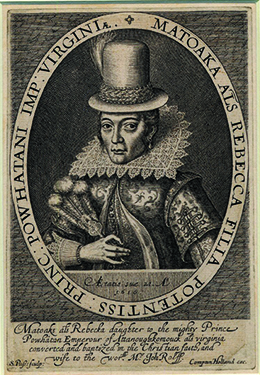| << Chapter < Page | Chapter >> Page > |

Explore the interactive exhibit Changing Images of Pocahontas on PBS’s website to see the many ways artists have portrayed Pocahontas over the centuries.
Peace in Virginia did not last long. The Second Anglo-Powhatan War (1620s) broke out because of the expansion of the English settlement nearly one hundred miles into the interior, and because of the continued insults and friction caused by English activities. The Powhatan attacked in 1622 and succeeded in killing almost 350 English, about a third of the settlers. The English responded by annihilating every Powhatan village around Jamestown and from then on became even more intolerant. The Third Anglo-Powhatan War (1644–1646) began with a surprise attack in which the Powhatan killed around five hundred English colonists. However, their ultimate defeat in this conflict forced the Powhatan to acknowledge King Charles I as their sovereign. The Anglo-Powhatan Wars, spanning nearly forty years, illustrate the degree of native resistance that resulted from English intrusion into the Powhatan confederacy.
The transition from indentured servitude to slavery as the main labor source for some English colonies happened first in the West Indies. On the small island of Barbados, colonized in the 1620s, English planters first grew tobacco as their main export crop, but in the 1640s, they converted to sugarcane and began increasingly to rely on African slaves. In 1655, England wrestled control of Jamaica from the Spanish and quickly turned it into a lucrative sugar island, run on slave labor, for its expanding empire. While slavery was slower to take hold in the Chesapeake colonies, by the end of the seventeenth century, both Virginia and Maryland had also adopted chattel slavery—which legally defined Africans as property and not people—as the dominant form of labor to grow tobacco. Chesapeake colonists also enslaved native people.
When the first Africans arrived in Virginia in 1619, slavery—which did not exist in England—had not yet become an institution in colonial America. Many Africans worked as servants and, like their white counterparts, could acquire land of their own. Some Africans who converted to Christianity became free landowners with white servants. The change in the status of Africans in the Chesapeake to that of slaves occurred in the last decades of the seventeenth century.
Bacon’s Rebellion, an uprising of both whites and blacks who believed that the Virginia government was impeding their access to land and wealth and seemed to do little to clear the land of Indians, hastened the transition to African slavery in the Chesapeake colonies. The rebellion takes its name from Nathaniel Bacon, a wealthy young Englishman who arrived in Virginia in 1674. Despite an early friendship with Virginia’s royal governor, William Berkeley, Bacon found himself excluded from the governor’s circle of influential friends and councilors. He wanted land on the Virginia frontier, but the governor, fearing war with neighboring Indian tribes, forbade further expansion. Bacon marshaled others, especially former indentured servants who believed the governor was limiting their economic opportunities and denying them the right to own tobacco farms. Bacon’s followers believed Berkeley’s frontier policy didn’t protect English settlers enough. Worse still in their eyes, Governor Berkeley tried to keep peace in Virginia by signing treaties with various local native peoples. Bacon and his followers, who saw all Indians as an obstacle to their access to land, pursued a policy of extermination.

Notification Switch
Would you like to follow the 'U.s. history' conversation and receive update notifications?